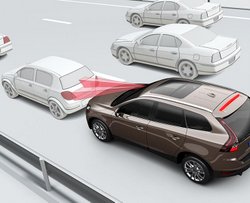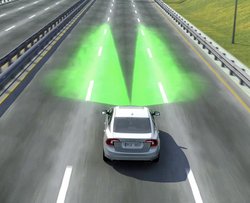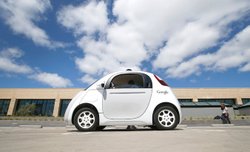They’re Coming Soon Than Predicted
[Ed. note: We’re republishing this article because it’s a good reminder of how technology timelines can slip and yet things are clearly moving forward. This article was written more than 10 years ago, when the forecasts were we would have personal and public robotaxis galore. Recent news of accidents are a reminder that these things take time. The technology has gotten better and many of the elements of self-driving cars are already embedded into our current automobiles. The ride continues.]
This article may contain affililate links.
By 2020, you will be able to own a car with advanced safety features helping avoid collisions, preventing you from drifting into the next lane, providing valet parking and allowing you to touch an “autopilot” button to have the car drive itself. Tesla, Volvo, Mercedes (Daimler), BMW, Audi, GM, Ford, Nissan, Toyota and others are now delivering cars with some of these features and developing cars with all of these. Most of these advanced vehicles will be electric or plug-in hybrids.
In the next 10 years, in select cities, you will also use a phone app to have a small autonomous vehicle pick you at your current location and shuttle you between transit and work or airport.

Advanced technology, prototype vehicles, and business plans are being developed by Google, car sharing services like Car2Go (Daimler), Uber, automakers, network providers, software and technology suppliers. Several of these firms confirmed their progress at Silicon Valley Connected & Charged Symposium, hosted by software giant SAP. From Shanghai to Singapore to Silicon Valley, you will see these services sooner than most forecast.
According to a new report from Navigant Research, worldwide revenue from connected vehicle systems is expected to grow from $96.3 million annually in 2016 to $36.6 billion by 2025. Lux Research sees an even bigger market for advanced driver assistance systems (ADAS) including lane departure warning, automatic parking, autonomous emergency braking, lane keeping assist, radar, Lidar, other sensors, cameras, V2V (vehicle-to-vehicle) connectivity, mapping technology and software enable ADAS features. Lux estimates ADAS revenue growing from $2.4 billion today to $102 billion in 2030; a 26% CAGR (compound annual growth rate).
Five Levels of Autonomy
The National Highway Traffic Safety Association (NHTSA) classifies five levels of autonomy:
- No-Automation (Level 0): The driver is in complete and sole control of the primary vehicle controls – brake, steering, throttle, and motive power – at all times.
- Function-specific Automation (Level 1): Automation at this level involves one or more specific control functions. Examples include electronic stability control or pre-charged brakes, where the vehicle automatically assists with braking to enable the driver to regain control of the vehicle or stop faster than possible by acting alone.
- Combined Function Automation (Level 2): This level involves automation of at least two primary control functions designed to work in unison to relieve the driver of control of those functions. An example of combined functions enabling a Level 2 system is adaptive cruise control in combination with lane centering.
- Limited Self-Driving Automation (Level 3): Vehicles at this level of automation enable the driver to cede full control of all safety-critical functions under certain traffic or environmental conditions and in those conditions to rely heavily on the vehicle to monitor for changes in those conditions requiring transition back to driver control. The driver is expected to be available for occasional control, but with sufficiently comfortable transition time.
- Full Self-Driving Automation (Level 4): The vehicle is designed to perform all safety-critical driving functions and monitor roadway conditions for an entire trip. Such a design anticipates that the driver will provide destination or navigation input, but is not expected to be available for control at any time during the trip. This includes both occupied and unoccupied vehicles.
You Can Buy Level 2 Today
For almost 20 years, drivers have used technology like cruise control. Now, telematics and advanced safety is comprehensive. When I drove the Toyota Avalon Hybrid with adaptive cruise control, the car automatically slowed when I too quickly approached the car in front of me. My test parallel park of Ford Escape was a breeze when the SUV parked itself. You may already be using technology that facilitates better driving, such as GPS navigation, backup cameras, lane-keep warning, automatic parallel parking and adaptive cruise control.

Today, you can also buy Level 2 vehicles such as the Volvo XC90 with Intellisafe semi-autonomous capabilities such as lane keep, maintaining a safe distance from the car in front, and a 360-degree camera.
Each Tesla Model S built after October 2014 has a software upgradable to ADAS as we reported recently. The new Model S includes forward radar and camera, 12 long range ultrasonic sensors positioned to sense 16 feet around the car in every direction at all speeds, and an electric-assist braking system. Much like your phone and tablet, these Teslas receive software upgrades, continuing to improve their collision avoidance, lane keep and adaptive cruise control. Although Tesla calls their system Autopilot, the driver is normally required to be alert behind the wheel steering the car, except for hands-free parking.
Own a Level 3 in 2017
GM CEO Mary Barra announced that in 2017 it will offer its Super Cruise advanced driver assistance technology on the Cadillac CTS and possibly other models. With a touch of a button, Super Cruise accelerates and brakes to stay at freeway speeds, avoids collisions in stop-and-go traffic, and allows the Cadillac to steer itself under certain highway conditions.
The 2017, Cadillac CTS will include V2V communication in the hope of encouraging wider adoption of V2V. Wisely, GM does not require V2V for the autonomous steering, braking and lane-keeping to work. Few of the other vehicles on the road in 2017 will have V2V; few streets and intersections will have V2I (vehicle-to-infrastructure). GM and other automakers are moving ahead without waiting years or decades for wide deployment of V2V and V2I, collectively referred to as V2X.

In 2019, one hundred Volvo’s in Gothenburg, Sweden, will be on the road and will self-drive with the touch of a button. Volvo’s vision is that no one will die or be seriously injured in a new Volvo.
By 2020, more than 1,000 self-driving cars from several automakers will be on the roads of Ann Arbor, Michigan. V2V and V2I will be extensively tested in Ann Arbor and a few other locations in a partnership that includes several automakers, U.S. DOT, NHTSA and the University of Michigan. The automakers will include traffic-jam-assist, where the driver presses a button to have the vehicle self-drive at up to 30 mph during stop-and-go traffic.
Level 4 Prototype Cars on California Roads Since 2009
This summer (2015), Google will have several of its newest self-driving cars on the streets of Mountain View, its headquarters city. Although Google’s ultimate vision is autonomous vehicles that do not need a steering wheel or brakes, for legal compliance, these 25-mph prototypes will have both should a driver need to take over. Long term, these types of two-seat 25-mph vehicles could be ideal for shuttling people from rail and transit centers to work in cities.

Google, in partnership with Stanford University, has successfully had self-driving vehicles on the road since 2009. Self-driving is legal in California, but automakers must have at least $5 million in insurance or post a bond. So far, permits have been issued to Google, Mercedes-Benz, Tesla, Delphi, and Audi. Google has racked up a million autonomous vehicle miles.
If you are skeptical about self-driving cars being safe, you are not alone. In the six years of testing self-driving cars, Google has reported 11 accidents: seven involved being rear-ended, two were sideswipes, and one was a collision with a car rolling through a stop sign. No one was hurt. None of the accidents appear to be the fault of the autonomous car. In contrast, 2.5 million people each year go to the hospital due to accidents in human-driven cars. In 2013, more than 32,000 people died as a result of traffic accidents. Human driven cars are the number one killer of Americans aged 4 to 35. Advanced vehicles are proving safer.
The best of the ADAS and self-driving cars have 360-degree vision with no blind spots. They are the best of defensive driving. Self-driving cars don’t get distracted by kids fighting in the back seat, by texting or having an emotionally stressful day. Autonomous vehicles brake faster if they are in danger of hitting someone.
Using Velodyne Lidar, radar, cameras, GPS, sophisticated algorithms and machine learning, Google cars have successfully navigated through windy roads, blind spots, unpredictable pedestrians, bike riders, and other cars without needing the V2X that some automakers are betting on.
By 2025, at least one major city will have thousands of Level 4 two-seat electric vehicles that pick you up when requested by your smartphone app and take you to your destination. Think of a

convergence of Car2Go, Uber, and Google maps. Advanced planning is already occurring in Singapore, Shanghai, and Silicon Valley cities from San Francisco to San Jose.
ADAS and autonomous vehicles will win because they will save more than a trillion dollars: insurance premiums will be lowered, healthcare costs from accidents will drop, renewable energy will replace gasoline, highways won’t need to be widened, DUI tickets will disappear and less police will be needed. This could save you a small fortune on a hardship license lawyer, as you can’t get banned from driving when you are behind the wheel of a car that drives itself.
Today, we can buy a car with ADAS features like lane keeping, adaptive cruise control and automatic emergency braking. Soon, we will able to buy a Level 2 or Level 3 autonomous vehicles. In the years ahead, we will be driving ADAS cars and using autonomous vehicle services to move faster, smarter, and safer.
Related Stories You Might Enjoy:
Feature: Elon Musk on the Near Future of the Autonomous Car
Feature: New Autonomous Cars & Connected Mobility

I’m just really skeptical of any level 4 stuff after we get beyond carefully maintained and pampered test cars. How many levels of redundancy will the sensors and actuators need? How often will they need to be maintained and calibrated? What sort of certifications will the software require? How will the car handle failures of any of its systems? How will the car handle a failure of a system in the other car speeding toward it?
When I click on a link to some article about how infallible self driving cars will be, and my up to date browser crashed to the desktop, I have to wonder, you know? I can’t think of any software I use every day that doesn’t have stupid bugs, including the expensive engineering tools I use at work. Hence my certification question. Will it need avionics SW level of control?
I can’t find anyone talking about these details. Just geeky, rose colored fluff. And if I ask questions, I get called “Luddite” by people who really need to look that word up.
This article was OK, though. Nice overview.
@JustSomeGuy,
Those are all the questions everyone is asking and you can be sure they will be answered before these cars get out on the road in any quantity. You can be assured as well that more and more self-driving cars at various levels of autonomy are going to be out on the roads challenging both our trust in technology and the technologies ability to integrate into the real world. To be honest, I don’t think the weak link is the softare–it’s the human factor. –Ed.